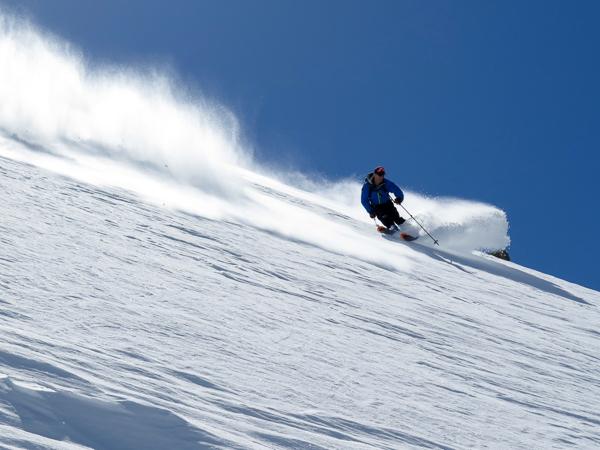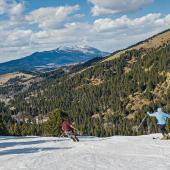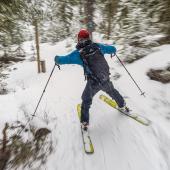Pre-Season Ski Conditioning
Prepping properly for the slopes.
Try to remember when it happened. Almost without warning, your days as an avid outdoor bum came to an abrupt and decisive end. Graduation, marriage, a career, the desire to own a car you didn’t have to push-start—whatever it was, your priorities shifted and instead of working nights part-time and training hard outside every day, you settled into a new routine, one that eroded your hard-won fitness level like a surging spring thaw grinding away the banks of the Yellowstone.
Nowhere is this degenerative phenomenon more evident than in the dreaded first few weeks of ski season, when we find our thirty- and forty-something selves seated in the lodge by 2:00, resting our exhausted quads instead of tearing it up ‘til last chair. The good news is that no matter what your age, workload, or amount of responsibility, there are plenty of great training methods you can use now, well before the snow flies, to prepare yourself for top-to-bottom runs on the first day of the ski season. Eccentric loading, metabolic conditioning, and balance training are three ways to significantly improve your early-season performance and stamina, as well as enhancing the way you ski in the future.
Eccentric loading allows our muscles to make structural adaptations to prevent future damage. Basically, this means training your muscles to prevent Delayed Onset Muscle Soreness (DOMS)—a major inhibitor of optimal athletic performance. DOMS results from micro-tears that develop in our muscles from muscle contractions that occur as the muscle is lengthening, and is associated with exercise-activated muscles that haven’t been worked out in a very long time. To make your legs DOMS-proof, perform eccentric loading techniques like downhill walking or running. Coming down from the “M” the steep way forces you to use your legs to brake, thus controlling your speed. This action is very similar to the braking we do during skiing when we turn to control our speed. Try the “Super Legs” exercises (see below) to eccentrically load your legs and prime them for the upcoming season.
Metabolic conditioning is the practice of using sport-specific motions in an exercise set lasting a pre-determined period of time. Training the muscles you use while skiing will enhance metabolic function, thus improving your stamina during a descent of the mountain. A typical run at Bridger Bowl takes anywhere from 30 to 90 seconds. While skiing, large leg and core muscles are constantly activated and your various upper-body muscles fire intermittently. Lifting weights for three sets of 10 repetitions does very little to improve your performance under these circumstances. Perform “Over the Top” (see below) to increase the endurance of your body core and leg muscles.
Balance training is not only key for skiing, but also helps in just about every activity we perform every day. Improving your balance can be as easy as standing on one leg for 20 seconds without tipping over. You’d be surprised how many adults can’t actually do this. Balance training will not only enhance your skiing performance – it may also reduce your risk of injury. If you think your balance is pretty good, try the “Triple Flexion Toss,” which mimics movements that occur frequently during skiing and other sports. This exercise involves absorbing force by flexing the ankle, knee, and hip.
Start early (like now!) and perform these exercises in the gym, in the garage, or in your living room whenever you can. Even just a few times a week can greatly improve your stamina and performance on the ski hill this winter, and may just keep you from drifting even further away from the supremely fit outdoor bum you used to be. Happy skiing!
Exercises
Super Legs Stage 1
Place your legs in a split leg dip position, i.e., right leg forward, left leg back, split stance. You should be able to apply most of your weight through your right heel and some bodyweight through the back toes. Be sure that your front knee never goes past your toes. Lower your torso mostly over your front right thigh and while keeping your back flat, reach both hands to the floor. Continue to lunge in a small down/up rhythm, tapping the floor with your fingers, for 20 repetitions and repeat on the other leg.
Super Legs Stage 2
Instead of staying in a split leg dip position, lunge forward in an alternating pattern, torso over thigh, touching the floor with your fingers and pushing back to your starting standing position. This is a basic alternating forward lunge that emphasizes the loading of the forward lunging leg. Perform 20 reps. You can progress by adding 20 plyometric lunges (tele jumps), but it is advised to perfect the exercises in their basic form for safety. Work up to a set of 80-100 repetitions and you will really feel the eccentric load in your legs.
Over the Top
Place a medicine ball on one side of your body. Pick the ball up with both hands and lift it over the top of your head and place it next to your feet on the other side. While facing forward, side step over the ball one foot at a time. Repeat this about ten times and go back in the other direction. Although it sounds easy, most athletes slow to a crawl by 60 to 90 seconds of the drill.
Triple Flexion
While holding a medicine (weighted) ball or soccer or basketball, stand on one foot with knee in a flexed or bent position. Drop your center of gravity by bending your knee even more and toss the ball into the air, overhead, from a low position. Try to absorb the catch with your leg by flexing at your ankle, knee and hip. In the beginning and end of the exercise your hip, knee, and ankle should always maintain a flexed position. And oh yeah—you don’t get to touch the floor with your other foot.











